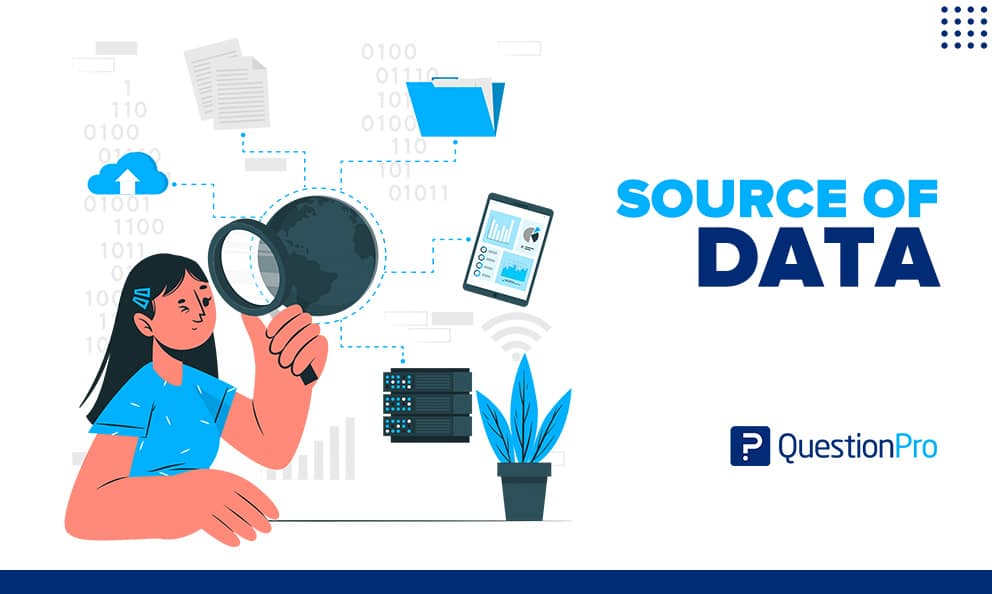
Data is the backbone of any data analysis work done in the research process. Data is a collection of unorganized facts and numbers from different sources. The sources of data can be different depending on what the research needs. Data analysis and interpretation are based solely on gathering different kinds of data from their sources. Researchers or analysts do the work of data collection to collect information.
LEARN ABOUT: Best Data Collection Tools
From this blog, we will learn about the definition of data sources with types and examples. So, stay with us to know more about it.
What are the sources of data?
In short, the sources of data are physical or digital places where information is stored in a data table, data object, or some other storage format.
Data can be gathered from two places: internal and external sources. The information collected from internal sources is called “primary data,” while the information gathered from outside references is called “secondary data.”
For data analysis, it all must be collected through primary or secondary research. A data source is a pool of statistical facts and non-statistical facts that a researcher or analyst can use to do more work on their research. Data analytics and data analysis are closely related processes that involve extracting insights from data to make informed decisions.
LEARN ABOUT: Level of Analysis
There are mostly two kinds of origins of information:The Sources of Data: Definition, types, and examples
- Statistical
- Census
Researchers use both data sources a lot in their work. The data is collected from these using either primary or secondary research methods.
Examples of sources of data
Here is an example of the data sources in action. Imagine a fashion brand that sells products online. The website uses an inventory database to determine whether an item is available. In this case, the inventory tables are a data source that the web application uses to serve the website to customers.
Types of data sources
-
Statistical data sources
Statistical data sources are surveys and other statistical reports used for official purposes. Here, people are asked several questions, which can be either qualitative or quantitative. Qualitative data sources don’t use numbers, while quantitative data do.
The data sampling method uses both kinds of statistical data. Usually, a sample survey is used to do a statistical survey. In this method, sample data is collected and then analyzed using statistical analysis plan and techniques. The surveys can also be done using the questionnaire method.
-
Census data sources
According to this method, the data are taken from the census report that was published earlier. It’s the opposite of statistical surveys. The Census method closely examines all parts of the population during the research process. Here, the data is collected over a certain amount of time, called the reference time. The researchers do their research at a particular time and then analyze it to conclude.
Census is done in the country for official purposes. The respondents are asked questions, which they answer. This interaction can take place in person or over the phone. However, the census is a source of data that takes a lot of time and effort because it involves the whole population.
Learn More: Data Collection Methods: Types & Examples
Additional sources of data
In addition to the above data sources, other origins are also considered when collecting data. These are what they are:
-
Internal sources of data
Internal data references are things like reports and records that are published within the organization.
Internal data references are used to do primary research on a given topic. As a researcher, you can go to internal sources to get information. All the work of the study is easy for it.
Some of the different internal data are accounting resources, sales force reports, internal experts, and miscellaneous reports. Practical business intelligence relies on the synergy between analytics and reporting, where analytics uncovers valuable insights, and reporting communicates these findings to stakeholders.
-
External sources of data
When data collection happens outside of the organization, it is called an external data source. In every way, they are outside of the company. As a researcher, you can work for external data collection.
The data from external origins is harder to gather because it is much more varied, and there can be many of them. There are different groups into which external data can be put. They are given below:
-
Government publications
Researchers can get a massive amount of information from government sources. Also, you can get much of this information for free on the Internet.
-
Non-government publications
Researchers can also find industry-related information in non-government publications. The only research problem with non-government publications is that their data may sometimes be biased.
-
Syndicate services
Some companies offer Syndicate services. As part of this, they collect and organize the same marketing information for all their clients. Surveys, mail diary panels, electronic services, wholesalers, industrial firms, retailers, etc., are ways they get information from households.
-
Experimental sources of data
In this data source, the information comes from related experiments and related tools. The researcher experiments to get all of the information they need.
Researchers can find out about the different ways that experiments can be set up. The four most common ways to run an experiment are:
-
CRD – Completely randomized design
A Completely Randomized Design is a simple experimental outline used in data analytics. It is based on randomization and replication. It is mostly used to compare the experiments.
-
RBD –Randomized block design
Randomized Block Design is an experimental design that divides the experiment into small units called blocks. Random experiments are run on each block, and the results are analyzed using the unit of analysis of variance technique (ANOVA). RBD originated in the agricultural sector.
LEARN ABOUT: ANOVA testing
-
LSD – Latin square design
Latin Square Design is an experimental design similar to CRD and RBD blocks but also has rows and columns. It comprises NxN squares with the same number of rows, columns, and letters that only appear once in a row. So, the differences are easy to find, and the experiment is less likely to go wrong. A Latin square design is something like a Sudoku puzzle.
-
FD – Factorial designs
Factorial design is an experimental design in which each experiment has two factors, each with a possible value, and additional combinational elements are derived from the results of the previous trial.
LEARN ABOUT: 12 Best Tools for Researchers
Conclusion
The sources of data are a complicated term. Simply put, a data source is a physical or digital place where the data in question is kept in a data table, data object, or another storage format.
Contact the QuestionPro team of experts if you need help researching. QuestionPro can help you get the most out of your data and guide you through the process.







